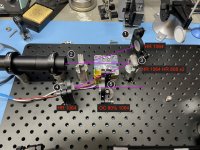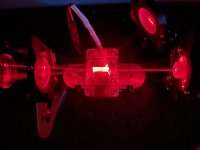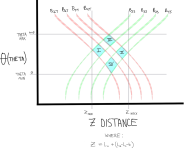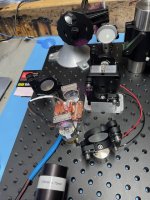brianpe
0
- Joined
- Dec 26, 2012
- Messages
- 55
- Points
- 18
I've been working on a DPSS laser for a while now. My goal is a frequency doubled Z-fold pumped by two 40w FAPs. I've done a ton of work on this, from designing my own power supplies and TEC controllers, to modeling the cavity via software to ensure stability and a decent beam waist in both the vanadate and KTP. This is my first "real" laser project, but I've done quite a lot of research and am making good progress.
I've had success getting a simpler L-fold cavity to lase up to about 4 watts (of IR...I did get green to work but very weakly) and have been able to repeat my alignment technique for getting the L-fold aligned. But the Z-fold is a whole different ball game. On the L-fold I had six spots to worry about: Three spots from front and back reflections of the resonator fold mirrors, and this was doubled by some refraction happening in the vanadate. On my Z-fold layout I have three fold mirrors, gobs of spots and the light from my HeNe isn't intense enough to be visible through a round trip (or I'm off so far I can't see where the spots are going).
Here is a photo of my layout with the mirrors numbered and annotated:

I started by replacing fold mirror #3 with OC #5 and aligning to get the L-fold lasing. Then I put fold mirror #3 back and I replaced mirror 5 with a pinhole and re-set my alignment laser to point into the cavity through the pinhole. I can get spots shining all the way back to mirror #1, but I just can't see anything coming back at the pinhole. Actually, I don't think my idea of getting the 1-2 arm of the L-fold aligned means much, since fold mirror 3 has no guarantee of following the exact same path.
Anyone done this? I'd sure like to learn some techniques.
I've had success getting a simpler L-fold cavity to lase up to about 4 watts (of IR...I did get green to work but very weakly) and have been able to repeat my alignment technique for getting the L-fold aligned. But the Z-fold is a whole different ball game. On the L-fold I had six spots to worry about: Three spots from front and back reflections of the resonator fold mirrors, and this was doubled by some refraction happening in the vanadate. On my Z-fold layout I have three fold mirrors, gobs of spots and the light from my HeNe isn't intense enough to be visible through a round trip (or I'm off so far I can't see where the spots are going).
Here is a photo of my layout with the mirrors numbered and annotated:

I started by replacing fold mirror #3 with OC #5 and aligning to get the L-fold lasing. Then I put fold mirror #3 back and I replaced mirror 5 with a pinhole and re-set my alignment laser to point into the cavity through the pinhole. I can get spots shining all the way back to mirror #1, but I just can't see anything coming back at the pinhole. Actually, I don't think my idea of getting the 1-2 arm of the L-fold aligned means much, since fold mirror 3 has no guarantee of following the exact same path.
Anyone done this? I'd sure like to learn some techniques.









